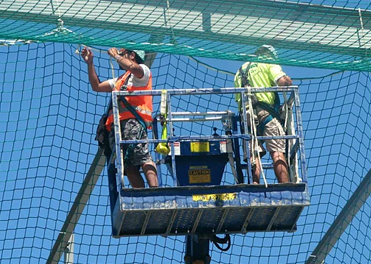What is Safety Net and How It Protect When Working at Height?

Safety nets, a ubiquitous sight in modern construction landscapes, are more than mere installations; they symbolize a commitment to safety and the well-being of workers. These intricately woven barriers, often taken for granted, play a monumental role in the world of high-altitude tasks. Serving as the unsung heroes of construction sites, bridges, and other elevated work areas, they act as the last line of defense against unforeseen accidents.
In this blog, we will explore the essence of safety nets, shedding light on their design, functionality, and the critical protection they offer. As we dive deeper, you’ll gain a newfound appreciation for these nets and understand their indispensable role in ensuring that those who work high above the ground return safely to their loved ones at the end of the day. Join us on this enlightening journey through the woven world of safety nets.
What’s Safety Net
Safety net systems refer to a set of protective measures, typically comprising meshed nets, designed to prevent injuries caused by accidental falls from heights or the dropping of objects. These systems are strategically installed at elevated worksites or below work areas to catch individuals or objects, thereby preventing direct impact with the ground or lower levels.
Importance of Safety Nets When Working at Height: Safety nets are paramount when working at height for several reasons:
Protection Against Falls: The primary purpose of safety nets is to act as a fall arrest system. In the event of a mishap, they provide a safety cushion, drastically reducing the risk of severe injuries or fatalities.
Prevention of Falling Objects: Beyond safeguarding workers, safety nets also prevent tools, materials, and other debris from falling to lower levels, protecting individuals below and preventing property damage.
Compliance with Safety Regulations: Many jurisdictions have stringent safety regulations for elevated work. Implementing safety net systems ensures compliance with these standards, reducing legal liabilities for businesses.
Enhanced Worker Confidence: Knowing that a safety measure is in place provides workers with peace of mind. This mental assurance can lead to increased productivity as workers can focus on their tasks without constant fear.
Cost-Effective Safety Solution: Compared to other protective measures, safety nets can be more economical, especially for larger areas. They offer broad protective coverage without the need for individual equipment for each worker.
Versatility: Safety nets can be adapted to various work environments, whether horizontal, vertical, or sloped, making them suitable for a wide range of applications.
In essence, safety nets play a pivotal role in ensuring a safer work environment at heights, protecting both workers and assets and fostering a culture of safety within industries.
1. Fall Arrest
Safety nets primarily function as a fall arrest system. In construction or any work at height, the risk of accidental falls is ever-present. Whether due to a loss of balance, equipment malfunction, or any other unforeseen circumstance, a worker can find themselves plummeting towards the ground.
The safety net acts as a protective barrier in these situations. When a worker falls, the net catches them, safely absorbing the force of their descent. This cushioning effect drastically reduces the potential for injury and ensures that the worker doesn’t make a dangerous impact on the ground.
2. Debris Catching
Beyond the protection of human lives, safety nets play a crucial role in preventing workplace accidents caused by falling objects. Construction sites, in particular, are rife with tools, materials, and other items that can accidentally be knocked over or dropped from a height.
3. Flexibility
The design and material of safety nets are chosen for their flexibility. Typically made with a mesh design, these nets can stretch upon impact. This stretching is vital as it allows the net to absorb the force of a falling object or person, much like a trampoline.
By dispersing this force, the net ensures that the caught individual or object doesn’t experience a sudden jolt, thereby minimizing the risk of injury.
4. Visibility
The bright colors of safety nets aren’t just for aesthetics. These colors ensure that the nets are easily noticeable, even from a distance. For workers operating at height, this visibility acts as a constant reminder of the safety boundaries in place.
It helps workers be more aware of their surroundings and the protective measures in place, reinforcing the importance of safety protocols.
5. Mental Assurance
The psychological aspect of safety cannot be understated. When workers know that there’s a safety net beneath them, it provides a significant boost to their confidence and peace of mind. This assurance allows them to concentrate better on their tasks, reducing the likelihood of mistakes caused by fear or anxiety about potential falls.
6. Compliance With Regulations
Safety regulations in many countries mandate specific protective measures for workers operating at height. These regulations are in place to ensure worker safety and reduce the risk of accidents. Safety nets are often a part of these mandated measures.
By installing safety nets, employers not only protect their workers but also ensure that they are in compliance with legal requirements, avoiding potential penalties or legal complications.
7. Versatility
Every worksite is unique, with its own set of challenges and requirements. Safety nets offer a versatile solution to fall protection, adaptable to various site conditions. Whether the need is for horizontal protection over a wide area, vertical barriers alongside a building, or sloped configurations on uneven terrain, safety nets can be adjusted and installed to fit the specific needs of the site.
8. Cost-Effective
Fall protection is essential, but it can also be expensive. Especially for large areas, installing guardrails or other protective systems can be cost-prohibitive. Safety nets offer a more economical solution in such scenarios. Their design and installation are often more straightforward and less resource-intensive than other systems, making them a cost-effective choice for many sites.
9. Reduction In Fall Distance
Other fall arrest systems, like harnesses, prevent workers from reaching the ground in the event of a fall. However, they might still allow the worker to fall a significant distance before halting their descent. This can result in injuries due to the sudden stop.
Safety nets, on the other hand, reduce this fall distance considerably. The net begins to stretch and slow the descent almost immediately, ensuring a softer and safer catch.
10. Easy Rescue
Accidents, even with safety measures in place, can be chaotic. Rescuing a worker who has fallen can be a complex task, especially if they are suspended in a harness. Safety nets simplify this process.
A worker caught in a net remains easily accessible, allowing for a swift and straightforward rescue without the need for specialized equipment or techniques. This rapid response can be crucial in ensuring the well-being of the fallen worker.
Conclusion
In the vast expanse of construction and elevated workspaces, safety nets stand as silent sentinels, ensuring that every misstep or unforeseen accident doesn’t turn tragic. Their presence, while often overlooked, is a testament to the industry’s dedication to safeguarding its workforce. As we’ve journeyed through the intricacies of these protective barriers, it’s evident that their role is not just functional but also symbolic of the value placed on human life and well-being.
In a world that constantly reaches for greater heights, it’s comforting to know that there’s a safety measure in place, ready to catch us if we fall. As we conclude, let’s take a moment to appreciate these unsung heroes of safety, for they represent the fine line between a routine day at work and a potential catastrophe.
- (This "Fire Safety Blogs" Published in April 2024 Edition)












